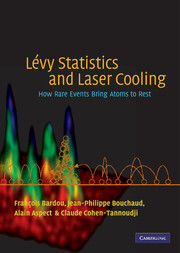Book contents
- Frontmatter
- Contents
- Foreword
- Acknowledgements
- 1 Introduction
- 2 Subrecoil laser cooling and anomalous random walks
- 3 Trapping and recycling. Statistical properties
- 4 Broad distributions and Lévy statistics: a brief overview
- 5 The proportion of atoms trapped in quasi-dark states
- 6 The momentum distribution
- 7 Physical discussion
- 8 Tests of the statistical approach
- 9 Example of application: optimization of the peak of cooled atoms
- 10 Conclusion
- Appendix A Correspondence between parameters of the statistical models and atomic and laser parameters
- Appendix B The Doppler case
- Appendix C The special case µ = 1
- References
- Index of main notation
- Index
Foreword
Published online by Cambridge University Press: 06 July 2010
- Frontmatter
- Contents
- Foreword
- Acknowledgements
- 1 Introduction
- 2 Subrecoil laser cooling and anomalous random walks
- 3 Trapping and recycling. Statistical properties
- 4 Broad distributions and Lévy statistics: a brief overview
- 5 The proportion of atoms trapped in quasi-dark states
- 6 The momentum distribution
- 7 Physical discussion
- 8 Tests of the statistical approach
- 9 Example of application: optimization of the peak of cooled atoms
- 10 Conclusion
- Appendix A Correspondence between parameters of the statistical models and atomic and laser parameters
- Appendix B The Doppler case
- Appendix C The special case µ = 1
- References
- Index of main notation
- Index
Summary
Long ago, Paul Lévy invented a strange family of random walks – where each segment has a very broad probability distribution. These flights, when they are observed on a macroscopic scale, do not follow the standard Gaussian statistics. When I was a student, Lévy's idea appeared to me as (a) amusing, (b) simple – all the statistics can be handled via Fourier transforms – and (c) somewhat baroque: where would it apply?
As often happens with new mathematical ideas, the fruits came later. For example, é. Bouchaud proved that adsorbed polymer chains often behave like Lévy flights. In a very different sector, J.P. Bouchaud showed the role of Lévy distributions in risk evaluation. Now we meet a third major example, which is described in this book: cold atoms.
The starting point is a jewel of quantum physics: we think of an atom in a state of 0 translational momentum p = 0 (zero Doppler effect), inside a suitably prescribed laser field. For instance, with an angular momentum J = 1 we can have two ground states │+〉 and │−〉, and one excited state │0〉. The particular state │+〉+│−〉 has an admirable property: it is entirely decoupled from the radiation and can live for an indefinitely long time. It is thus possible to create a trap (around p = 0 in momentum space) in which the atoms will live for very long times: this so-called ‘ subrecoil laser cooling’ has been a major advance of recent years.
- Type
- Chapter
- Information
- Lévy Statistics and Laser CoolingHow Rare Events Bring Atoms to Rest, pp. xi - xiiPublisher: Cambridge University PressPrint publication year: 2001
- 2
- Cited by



